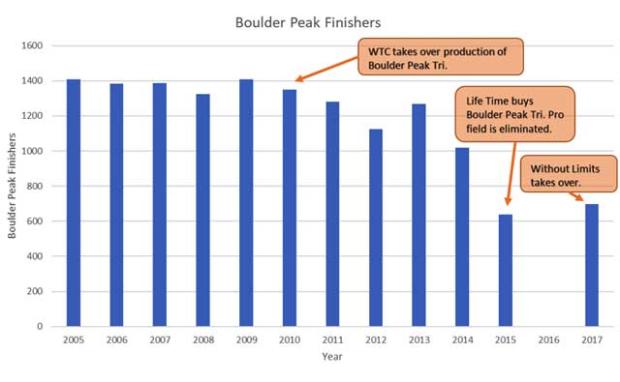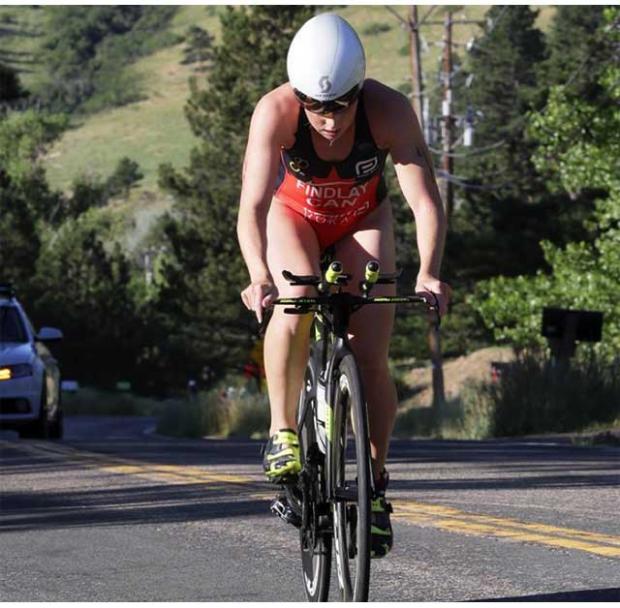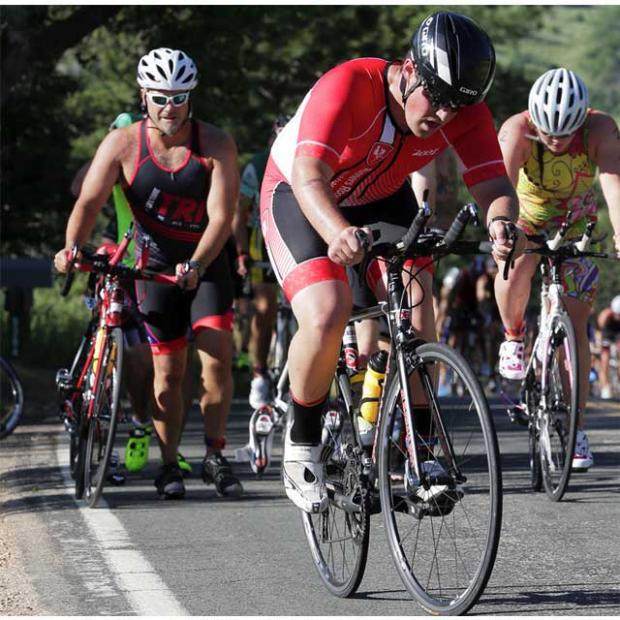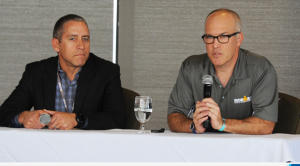The Boulder Peak Triathlon had been a must-do race for decades. But owners – including Ironman and Life Time – passed the race around like it was a journeyman shortstop, and declining entries left competitors thinking that the race had lost its mojo. But the Boulder Peak is back in the hands of a local independent race director. Reviews are positive, prognostications are bullish, and the race is no longer back on its heels.
In 1987 the Governor’s Cup Triathlon was canceled after a man was struck by a truck on Nelson Road during the bike segment. There had not been a triathlon in Boulder since then. Paul Karlsson and David Jensen met in 1991, and they decided it was time to bring triathlon back to their town. They wanted the race to reflect the community, so they put in a steep 12% grade climb on the bike course. “I wanted to put in something that was very Boulder, so that is why we put in Olde Stage [Road]. If we don’t have Olde Stage, what differentiates us from any race in Kansas?” said Karlsson.
There were 400 entries and a $500 in prize purse in its 1992 inaugural year. But because Boulder was already home to so many top triathletes, many of them began racing The Peak from its inception. Pro triathlete Bryan Rhodes has competed in almost every edition of the race. “I raced it in 1992 when the likes of [Ironman World Champions] Dave Scott and Mark Allen turned up, racing as a junior pro. It was pretty epic.”

Current Boulder Peak owner and race director, Lance Panigutti of Without Limits Productions, says that at the time “you could count the number of professional non-draft Olympic races on one hand: Chicago, Boulder Peak, St. Croix, St. Anthony’s, Escape from Alcatraz…This became a de-facto non-draft racing world cup series. Each of those races had a unique feature: the sand ladder at Alcatraz, the Olde Stage climb at Boulder Peak.” But the other quality that made Boulder Peak a must-do race for age-groupers was the character and sense of community that Karlsson brought to the race and blended with the elite pro field.
“One of the things that put us on the map was we did training seminars with Dave Scott, Paula Newby-Fraser, Scott Tinley, Greg Welch, Scott Molina, and Erin Baker. We get these top pros to do training seminars, and 40 to 50 people would show up and that gave us a lot of credibility,” recalls Karlsson.
There were other draws, too. Eight-time Ironman World Champion Paula Newby-Fraser suggested in 1996 that pro women get a fifteen-minute head start over the men, which brought out spectators to see who would cross the finish line first. And Karlsson instituted a side competition: Whomever had the longest transition won a lawn chair and a case of beer.

In 2004, Karlsson sold the Boulder Peak to 5430 Sports, run by Barry and Jodee Siff. Eric Kenney of EK Endurance Coaching has coached many age group and pro Peak participants since 2006 and competed in the race himself. Kenney recalls, “It wasn’t just a race for pros, it was a race for beginners, too…Barry did such a great job of knowing the people he was calling up to the podium by name, and so I think it had something for everyone, from pro to first-timer to everyone in between.”
In 2009 the race was sold to the Ironman (then known as World Triathlon Corporation, or WTC). The Siffs managed the 2009 race, but Ironman took over management in 2010 and many felt the personal touch and community brought by Karlsson and Siff had dried up. Entries began to decline. Of course, The Peak wasn’t the only race feeling the pinch. Though overall participation in triathlon was increasing according to the number of USA Triathlon memberships, the athletes were spread over an ever-growing number of Olympic-distance races in the region. Dave Christen of Ironman said, “In any industry when you have more stores selling the same product you will see a dispersion of customers across the stores.”
But there was still a sense among some athletes that the race was changing for the worse. “When the bigger corporations came in and bought [the Peak] from Siffy, it lost its feel,” said Rhodes.
Entries continued to decline, dropping from 1,407 finishers in 2009 to 1,018 in 2014, after which Ironman sold the race to Life Time Fitness. Of the sale, Christen says, “Life Time Fitness and Ironman have been long time partners, and we were expanding with Ironman Boulder in the Boulder market and it made sense for us to focus our attention there. Life Time is a leader in the industry and did a great job in producing the event as well.”

For the 2015 edition of the Peak, Life Time eliminated the pro race. The number of finishers plummeted to 639. Boulder athlete and founder of the Vixxen racing team, Liz West, says, “[I] raced it early on as your everyday, average age-grouper and really enjoyed the race–had fun with it. The year I did it that Life Time ran it, I just had a miserable time. I was frustrated with the race. I didn’t enjoy myself.” West described a poorly set swim course, a time-trial start within age group waves, and plastic cocktail cups at the aid stations that broke when she squeezed them. And, importantly, “The local flair of it wasn’t there,” she recalls.
“I would argue to every race director that having a pro race does not increase age group participation—except at Boulder Peak,” states current race director Panigutti. He maintains that in Boulder the age group and pro triathlon communities are interwoven. Racers and spectators alike in Boulder recognize the pros, maybe even know them personally, and they like to see them race and be associated with them. Because it’s their home course and training ground, the pros are more likely to hang out with the age-groupers in the beer garden afterward and chat. Pros are simply part of the fabric of the triathlon community in Boulder, and if they are excluded the atmosphere of the race is changed fundamentally for the age-groupers.
In 2016, Life Time did not plan to bring back the pro field, but they did announce a cash prize for the fastest relay team. Extremely fast relays were expected, with teams made not only of elite triathletes but also pure swimmers, cyclists, and runners. It was not to be. The race had to be canceled due to a lack of available emergency vehicles; they were all responding to a major forest fire in the region.

Life Time decided to sell The Peak to Without Limits Productions. Panigutti licensed the 5430 Sports brand from Barry Siff and created a series similar to what 5430 originally ran. It includes a spring sprint race, the Boulder Peak, and the autumn half-distance 5430 triathlon. Panigutti wanted to use the 5430 brand to distinguish these races as the premier series in Colorado. “The goal was to elevate the status of Boulder Peak to being a can’t-miss event. [An athlete] gets to go and feel that this is what makes the CO community so amazing.” says Panigiutti.
Entries were slightly up in the first year under new ownership with 707 finishers, but most participants feel the quality that made the Boulder Peak race great has returned. A $20,000 pro prize purse attracted Olympians and Ironman 70.3 Champions. A cash King/Queen of the Mountain prize for the first to reach the top of Olde Stage added some flair for the race. And Panigutti is bringing back Karlsson’s sense of fun: There was a slip n’ slide at the finish line.
Panigutti says, “I have seen a lot of races that are very, very professional, but so professional that it feels like the athletes are cattle being led through the corral. Other races are fun but so disorganized that no one knows what’s going on. I always said we can have the best of both worlds.”
Kenney was surprised by the number of spectators who lined this year’s course. “I was off in the third wave,” he says, “and I was thinking to myself, man no one’s gonna be watching the pros when they’re racing. I was surprised at how many people were out on the run course watching when I got out there.”
This year, Paula Findlay (pictured above) overcame challenges from Lindsey Jerdonek, Kaisa Sali, and Alicia Kaye to win the women’s race while Cameron Dye beat out top names like Rodolphe von Berg, Jason West, Jarrod Shoemaker, and Matt Chrabot to take first overall.

Rhodes says, “I’d love to see it get back to [selling out, with a] full parking lot. We’re headed in the right direction. It’s just going to take a bit of time. It holds a special place in my racing career. A lot of those races that are 25 to 30 years old are dying off and you’ve got to keep rolling it off. Hats off to Lance and Without Limits Productions for stepping up to the plate.”
Karlsson attended the race, and he’s pleased with the way things are going. “I’m excited that it’s back with Lance. I went [in 2015], and it was really depressing. They didn’t have many people signed up, the expo was really small…I’m really happy that Lance and Barry are the ones to bring it back.”
[All photos: Steve Pyle ]



